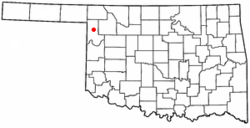Gage, Oklahoma
| Gage, Oklahoma | |
|---|---|
| Town | |

Artesian Beach Park in Gage
|
|
 Location of Gage, Oklahoma |
|
| Coordinates: 36°19′5″N 99°45′26″W / 36.31806°N 99.75722°WCoordinates: 36°19′5″N 99°45′26″W / 36.31806°N 99.75722°W | |
| Country | United States |
| State | Oklahoma |
| County | Ellis |
| Area | |
| • Total | 0.4 sq mi (1.1 km2) |
| • Land | 0.4 sq mi (1.1 km2) |
| • Water | 0.0 sq mi (0.0 km2) |
| Elevation | -2,146 ft (-654 m) |
| Population (2010) | |
| • Total | 442 |
| • Density | 1,100/sq mi (400/km2) |
| Time zone | Central (CST) (UTC-6) |
| • Summer (DST) | CDT (UTC-5) |
| ZIP code | 73843 |
| Area code(s) | 580 |
| FIPS code | 40-28250 |
| GNIS feature ID | 1093087 |
Gage is a town in Ellis County, Oklahoma, United States. The population was 442 at the 2010 census. Located in the central part of Ellis County on State Highway 46, thirteen miles north of Arnett, the county seat, and on Highway 15, twenty-one miles southwest of Woodward, Gage developed primarily because of transportation access. The military road from Fort Supply to Fort Elliott/Mobeetie, Texas, passed near the future town, and two miles to the northwest a stage stop existed at the confluence of Little Wolf and Wolf creeks. In 1887 the Southern Kansas Railway (later part of the Atchison, Topeka and Santa Fe Railway) had constructed a line across northwestern Oklahoma from Kansas to the Texas Panhandle. A station called Gage, for a Chicago railroad financier, was established in July near Wolf Creek. Once the domain of various Plains Indian groups, by that time this region had become part of the Cherokee Outlet, opened to settlement by a land run in September 1893. Santa Fe railroad depot, Gage OK, 1906
After that, Woodward County included the site of future Gage. A year after the run several settlers, including John Barr and Frederick D. Webster, took up land near the railroad stop. A post office was designated in February 1895, with Webster as postmaster. By 1898 the community was big enough to support a half dozen stores, a hotel, and a sawmill. In 1901 activity surrounding the opening of the Kiowa-Comanche-Apache lands, to the south, attracted new people to the town and farmers to purchase land nearby. The town's residents voted to incorporate a six-block area in May 1904. Eighteen months later, anti-liquor campaigner and Guthrie resident Carrie Nation, on one of her lecture tours through Oklahoma Territory, made a brief visit to Gage's saloons and met a cold reception. In 1907, when Ellis County was created, taking in this part of Woodward County, Gage's 1907 population stood at 755 and in 1910 at 924, the all-time peak.
The growing community served as a cattle and grain shipping point for the surrounding area. Prosperity in the first decade after incorporation attracted two banks, five lumberyards, and more than two dozen retail establishments. Two cotton gins, a roller mill, and three elevators served farmers. The Brennecke Metal Manufacturing Company made water and stock tanks. A theater and the Wolf Valley Cornet Band provided entertainment. Travelers patronized three hotels and five restaurants. Residents could attend any one of three churches, and children attended a large school building.
Like most rural centers, Gage suffered a decline in the World War I years, but the ideally located railroad town remained viable, as it was some distance from towns of any size. Newspapers serving the residents have included the Ellis County Advocate, the Ellis County Republican, the Gage Banner, and the Gage Record, with the latter continuing in existence at the end of the twentieth century. In 1920 the town had 804 inhabitants
...
Wikipedia
